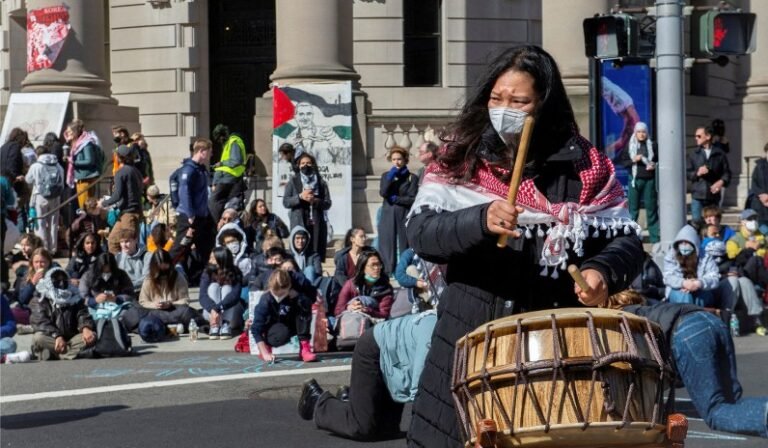A
fter my 50th high-school reunion this past Saturday, I visited the splendid, new-and-improved Peabody Museum, Yale’s natural-history museum, and the university’s art gallery. I grew up in North Haven, a ten-minute drive from Yale but another world. I got my Ph.D. at Yale. Indigenous as I was, I was an amalgam of town and gown. My maternal grandfather was an Italian immigrant and a construction worker, part of the crew that built the dozen or so residential colleges at Yale during the Depression. It’s always good to visit the campus, even better this Memorial Day weekend to collate then and now.
Yale, praise the Lord, doesn’t have Harvard’s pathologies, or at least not their depth and toxicity. By the by, brimming with good though unorthodox ideas as I am, I wrote a few months ago that Harvard University belongs in receivership because of its board’s gross negligence. The school’s thick with Jew-hate, the ultimate social cancer. The trustees hired a serial plagiarist as president. The Supreme Court said its admissions policy was illegal. Goodness, a Harvard medical-school staffer illegally sold dead bodies Harvard inherited for research. A more ostentatious abuse of donor intent is hard to imagine.
Trustee incompetence sticks out like a sore thumb, foot, and schnozzola, all for sale on eBay.
I still think it’s a good idea and deserves repeating. The left-wingers running the Commonwealth of Massachusetts would never, ever, not in a million years seize Harvard and put right-thinking alums like Larry Summers, Ben Sasse, Tom Cotton, Bill Ackman, or even Mitt Romney on the board to cleanse the Augean stables in Cambridge. Unless they got a cut. How’s 10 percent for the big commonwealth, to tweak a line from the Biden crime family’s business model — you know, 10 percent for the Big Guy. Harvard’s endowment is $50 billion. The State House drains $5 billion, say, for what we can call administrative costs while Harvard gets a top-to-bottom makeover.

In contrast to Harvard’s orgy of antisemitism, Yale’s crypto-Nazi, pro-Hamas encampment was a limited affair, though Jewish students there have had a rough time for years. Yale’s aggressive affirmative-action program has reduced the number of Jewish students from what was once a critical mass too big to harass to a tiny number more convenient to target. After I visited the Peabody Museum, Yale’s beautifully renovated and expanded natural-history museum, I walked to the Yale University Art Gallery through Beinecke Plaza, where some of the pro-Hamas protests occurred, and Cross Campus, the lawn in front of the university library and site of the encampment that Yale’s and New Haven’s police departments dismantled on April 30.

Beinecke Plaza, also known as Hewitt Quadrangle, is my favorite spot on campus. The rare-book library is there as well as the president’s office, the old dining hall, and Woolsey Hall, Yale’s biggest auditorium. It’s a concert hall and memorial to Yale’s war dead from the American Revolution to the misadventures in Iraq and Afghanistan. Hewitt Quadrangle is also home to Yale’s World War I cenotaph. Engraved in the frieze of the dining hall are the main World War I battles where Yalies served.
The space isn’t big. It’s intimate and majestic at the same time. Hewitt’s buildings, except the rare-book library, a product of the ’60s, commemorated Yale’s 200th birthday in 1901. The Beaux Arts architects John Carrère and Thomas Hastings designed the buildings and the plaza. It’s dispiriting to know that the hateful pro-Hamas rally happened steps from memorials to men and women who died for freedom and humanity. The encampment in front of the library couldn’t have been more galling. Learning’s supposed to annihilate hate. I think even at Yale, which has lots of smart people, many have been educated beyond their intelligence.

The Yale Center for British Art, known as the YCBA, is still closed, irritating to me since it’s one of my favorite museums. I’ve been going there since it opened in 1977, for years as a townie and, later, as a student. The museum is replacing its roof, and it’s taking forever. I know museum time is like geological and biblical time, even dinosaur time, but this is absurd.
Courtney Martin, the director of the YCBA, is leaving at the end of June to be the head of the Rauschenberg Foundation. This seems predictable and, at least for the YCBA, a good move. She’s led the country’s superb museum of British art for five years and is one of those museum directors I’d describe as a nonstarter.
Before Martin came to the YCBA, she’d been an assistant curator and an adjunct art-history faculty member for a short time. She never worked at a museum with a permanent collection. I met her once, read her dissertation, which was fine, think she’s very nice, but she never ventured far from her comfort zone, which is the art of race. Her dissertation was on black British artists from the ’60s to the ’80s. Her programs at the YCBA stuck to narrow, race-driven themes. The big exception was a very good exhibition on Henry Moore’s work during World War II. It was the museum’s chief curator’s project, on which she worked for years.
That the YCBA closed for a year and a half for Covid soon after Martin arrived wasn’t her fault, though I don’t think anyone at Yale was much troubled by the public’s exclusion from one of its anchor culture venues. New Haven and the towns around it, about half a million people, are unusual in that Yale’s museums are the local civic museums as well. Yale kept these museums closed for far too long. Only a few short months after the YCBA finally reopened, it closed again for the roof work.
When I was the director of the Addison Gallery, in a distinguished old pile designed by Charles Platt and dating to 1931, I oversaw the emergency replacement of its glass roof. It took only eight months. So far, it’s taken the YCBA a year, and I can’t get a date from the museum on its reopening.
On Thursday I wrote briefly about the Peabody Museum’s once-impressive Hall of Native American Cultures, now gone and consigned to the museological Witness Protection Program. This developed from a new Biden administration interpretation of the Native American Graves Protection and Repatriation Act, or NAGPRA. It’s the 1990 law requiring museums to return grave goods in their collections to tribes. The law worked well for over 30 years, requiring as it did persuasive evidence — scientific, cultural, biological, technological, stylistic, or oral-history evidence — that art and artifacts were taken from graves, often by gringo archaeologists.
A new rule was plucked last year from what might have been Chief Thundercloud-in-the-Sky but has no basis in legislative intent. It tosses evidence out of the tepee flap in favor of “indigenous ways of knowing,” which can’t be challenged in courts. These ways now include spectral evidence. And old Native American artifacts and art can’t be displayed without tribal permission. At least a dozen museums, among them the Museum of Natural History, the Field Museum in Chicago, and Harvard’s natural-history museum, have truncated their Native American displays. Yale did the same. Getting tribal permissions was too big a hassle. Natural-history museums are turning squirrelly about what they have.
Everyone loses — museum goers, scholars, and the tribes themselves. They’ll learn less about their own histories. Only the extremists win. Like all extremists, they want people kept uninformed. Thus the Hall of Native American Cultures went the way of Uncas and Chingachgook.
A Pair of Anxious Painters

Munch and Kirchner: Anxiety and Expression is the very good exhibition on view at Yale’s art gallery, across the street from the YCBA and actually open. It looks at ways the Norwegian Edvard Munch (1863–1944) and the German Ernst Ludwig Kirchner (1880–1938) used art to navigate severe depression and substance abuse. The exhibition draws on Yale’s print collection as well as art belonging to collectors with close ties to Yale. I reviewed the Clark Art Institute’s Munch landscape exhibition last year, neither liking it too much nor disliking it.
Munch exhibitions are aplenty these days as is, at least on Yale’s campus, a surfeit of depression, paranoia, self-loathing, and anxiety. Both artists spent so much time in spas and private psychiatric hospitals that their doctors became close friends with them and collectors of their work. I wondered whether a tiramisu — a pick-me-up — exhibition might have been best. Of course, exhibitions are planned years in advance. No one could have imagined that Yale’s campus would be infested with Hamas apologists.
More to the point, Munch and Kirchner were printmakers of the first rank. Seeing Munch’s Toward the Forest woodcuts and Kirchner’s Moonlit Night were worth the risk of absorbing even a smidgen of their angst. The show’s presentation and labels are up to Yale’s typical high standards. After my visit to Munch and Kirchner, I did venture to Yale’s French avant-garde galleries. One of my favorite pictures there is Manet’s Reclining Young Woman in Spanish Costume, from around 1862. She’s a fleshy woman dressed up as a man, and a Spanish torero at that. She reclines on a red velvet chaise longue that sets off her white legs. A cat paws an orange, looking mischievous, as does the young woman with that come-hither look. The chaise longue has casters, then a new feature in bourgeois furniture. Everything, it suggests, is movable. Olé!

